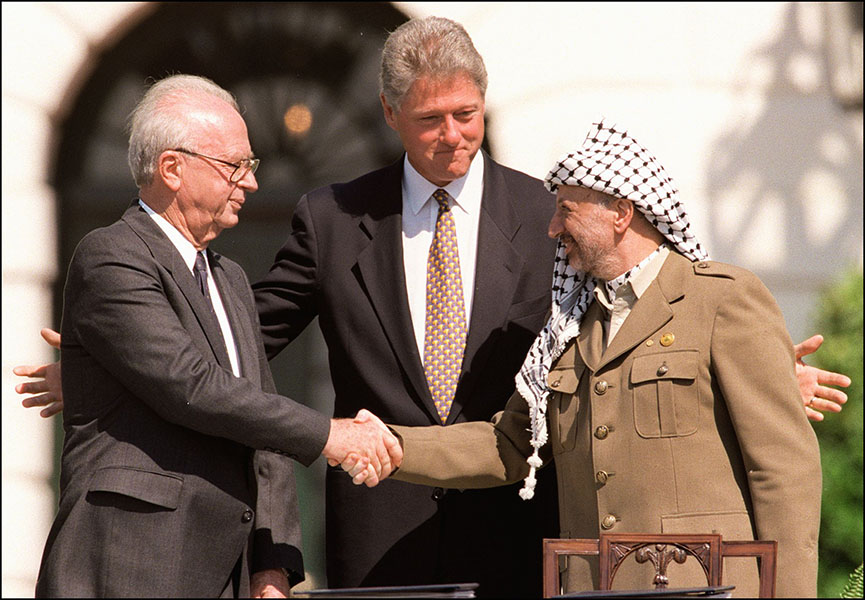The limitations of a wall
By Arnaud de Borchgrave, UPI Editor at Large
WASHINGTON — Particularly galling to the Israeli government is the belated discovery that “security fences,” no matter how robust, can be flown over by hundreds of homemade Qassam rockets and tunneled under by Palestinian fighters to kidnap an Israeli soldier on the other side.
Snaking in and out of Palestinian territory to protect Israeli settlements, the $2.5 billion, 456-mile barrier is in some parts twice as high (8 meters) and twice as wide (104 meters) as the defunct Berlin Wall that divided East and West Berlin. The approaches on the Palestinian side are first fine sand to make footprints visible and then razor barbed wire. High voltage circuits run through the so-called “smart fences” that line the perimeter of the barrier. And between the fence and the wall is a trench, two meters deep, studded with sharp metal spikes.
At certain intervals, there are 10-meter-high steel poles that hold up stadium-bright lights and surveillance cameras. But the costly $2.5 billion ditch-fence-wall could not protect Cpl. Gilad Shalit who was dragged into a tunnel under the Israel-Gaza border — and held for ransom of 1,500 Palestinian prisoners out of 8,503 now in Israeli prisons. A Palestinian rocket also hit a school parking lot in the center of the southern coastal city of Ashkelon (pop.: 110,000), seven miles north of Gaza.
The Israeli reaction demonstrated yet again that the very notion of an independent “viable and contiguous” Palestinian state was an oubliette-in-the-air. Prime Minister Ehud Olmert, approving each step proposed by the army and Shin Bet, reacted as if he was cleaning up a tough neighborhood in his own city. But it had little to do with freeing a 19-year-old tank gunner doing his three years of compulsory military service.
Israeli aircraft, gunboats and artillery pounded mostly empty areas of Gaza as hundreds of tanks took up positions in the south, west and north of the miserable coastal strip Israel evacuated last September. The bomb that knocked out Gaza’s principal power station plunged half of Gaza’s 1.3 million into darkness with no potable water or ventilation in the 105 degree daytime heat. It also stopped electric water pumps and sewage disposal systems. Taken prisoner from their homes at night were 64 elected Hamas parliamentarians, including eight cabinet ministers. The Prime Minister’s office and the Interior Ministry took direct hits, as did an empty building on the Islamic University campus. Breaking the sound barrier over President Bashir Assad’s palace in Damascus was designed as a warning to Syria to quit hosting Hamas leader Khaled Mashaal.
Hard to envision independent Palestinian state
If Cpl. Shalit is killed, warned Israeli Minister Roni Bar-On, “it’s safe to say the sky will fall on them… in ways the Palestinians haven’t seen before.” Compared unfavorably, even in the Israeli media, was Palestinian fighters taking an Israeli soldier prisoner while the Israeli army retaliated by kidnapping scores of civilian prisoners. Clearly Israel had a much larger agenda than getting Shalit back unscathed.
Unmentioned in the brouhaha was the proximate cause of the Shalit incident. Two weeks before, Israel had successfully targeted a ranking Hamas official for assassination. Jamal Abu Samhadana, wanted on both the U.S. and Israel’s terrorist lists, had recently joined the Hamas Interior Ministry to take command of Gaza’s police forces.
Following Hamas’ victory in free and fair elections last January, the “Hamas Team” in Jerusalem met at the highest level to decide how Israel should respond. Everyone agreed on the need to impose an economic siege on the Palestinian Authority. The prime minister’s principal adviser Dov Weissglas elicited chuckles all around when he said, “It’s like an appointment with a dietician. The Palestinians will get a lot thinner, but won’t die.”
It was hard then, even harder today, to imagine worse conditions for Gaza’s hapless population with jobless rates up to 40 percent. And harder still to imagine an independent Palestinian state as far as anyone can read Mideast tea leaves. What Olmert calls “convergence,” and which President Bush prefers to call “realignment,” is a plan to squeeze a Palestinian state between the new barrier and an Israeli security zone along the Jordan River. That, too, was now a bridge too far. Some 60,000 Jewish settlers, confident they are not about to be evacuated, are building new security roads between the 60-odd settlements east of the barrier that are supposed to be dismantled under Olmert’s plan.
The Shalit abduction took place, as Hamas and Fatah, defeated in the elections, were crabwalking toward an unspoken tacit acceptance of Israel’s right to exist — but still far short of the international community’s insistence that Hamas recognize Israel with no ifs or buts. As a first step, Hamas and Fatah seemed to have accepted the principle of a national unity government. The latest crisis in Palestinian-Israeli relations is the umpteenth step away from the ever-elusive peace process. A majority of Israelis in recent polls now oppose any kind of West Bank evacuation.

